PC Evolution
by Howard Fosdick © 2025 RexxInfo.org
How have personal computers evolved over their decades-long history? That's what this article summarizes.
If you have an old computer you want to refurbish, this information is key to figuring out what you have and how you can use it.
Which old computers can be useful, and what can they be used for? Which are junk? Let's find out.
Processors

First off, we need to understand processor cores and threads.
A core is simply a processor. It's what people used to call a central processing unit or CPU. For their first 25 years, each personal computer had a single core.
By around 2005 or so, PCs evolved to having two processing units or cores. Each supported an independent processing stream, or thread.
Then about 2010, computers blossomed into multiple cores on a single chip. Each core typically supported a couple independent threads.
A common configuration was four cores and eight threads, as shown in the diagram.
You'll sometimes see more cores and many more threads in current machines.
This next chart provides a rough timeline of this evolution. Keep in mind that there was no rigid start and end times for these technologies -- they overlapped in the consumer marketplace. This figure also shows how versions of Windows mapped on to processor technologies.

Passmark Software's website benchmarks thousands of processors. You can use it to look up your processor and compare it to others.
Memory
Memory is another component that determines PC power, in two respects:
- How much memory does the PC have?
- How fast is it?
Memory generations are denoted by their "double data rate" or DDR number.
This chart shows how memory has evolved over generations. Each generation is faster and more dense than the previous:
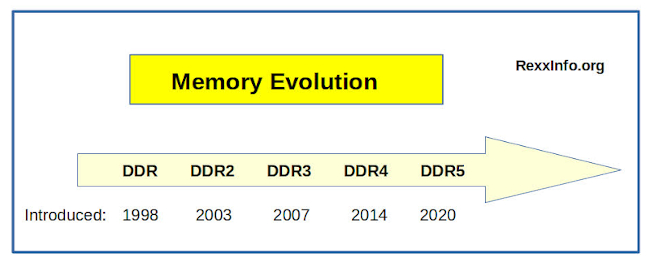
(Sometimes you'll hear DDR numbers referred to by their corresponding PC numbers, such as PC, PC2, PC3, PC4, and PC5.)
These charts show how memory capacity and performance have improved over DDR generations:
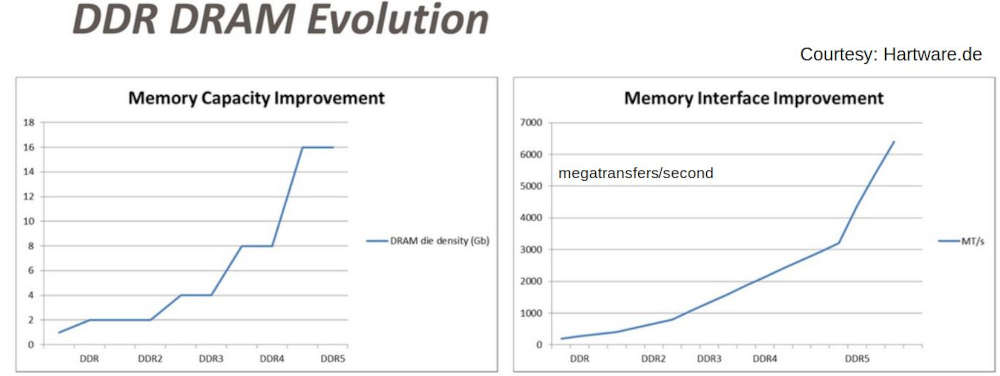
Storage
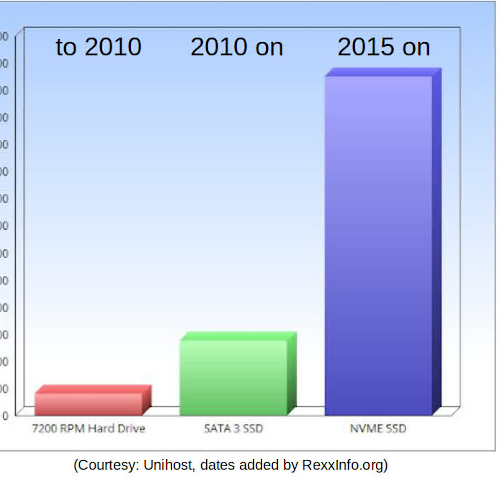
Storage capacity and speeds are another key component of computer power.
This chart shows how storage in the 21st century has evolved:
-- from rotating hard disk drives (HDDs)-- to Sata connected solid state drives (SSDs)
-- to NVMe SSDs (also called M.2 disks)
A Sata connected SSD is several times faster than earlier hard disk drives.
And the current M.2 drives are even faster. They provide a huge performance improvement over the Sata connected drives.
Other Components
Many other components factor into how powerful and useful a personal computer may be. They include:
- Graphics processors and graphics memory
- Display resolution and screen sizes
- USB speeds and capacities
- Internet and Wifi speeds
- Operating system and applications software
To simplify the discussion, we'll leave these components out of this article.
For charts that describe the evolution and improvements in these areas, please see my related article.
Which Technologies Go Together?
This chart shows the technologies that tend to occur together in what I call computer generations. It summarizes what I most commonly encounter when I pick up old computers to refurbish.
Note that there are no hard and fast rules about which technologies you will find together. What you encounter may vary because technologies enter and fade from the marketplace over several years.
| Generation: | Examples: | Most Popular: | Number of Cores / Threads: | Passmark Benchmark: | Memory: | Disk: | Other Storage: | Display: |
| Current Multicore | Intel i-Series | 2021 on | 4 to 8 / many | > 10,000 | DDR4 or DDR5 | M.2 SSD | USB sticks, External Disk | HDMI, DisplayPort, (VGA) |
| Mature Multicore | Intel i-Series | 2011 - 2020 | 2 / 4 or 4 / 8 | 2,000 - 10,000 | DDR3 or DDR4 | Sata SSD | USB sticks, External Disk | HDMI, DVI, (VGA) |
| Dual Core | Core 2 Duo | 2005 - 2011 | 2 / 2 | 750 - 2,000 | DDR2 | Sata HDD | Optical Disc, USB sticks, External Disk | DVI, VGA |
| Single Core | Pentium IV, Pentium M | 2000 - 2007 | 1 / 1 | < 750 | DDR | IDE HDD | Optical Disc, Zip Drive | VGA |
Evaluating a Computer
So, what does this all mean?
We can generalize about the uses of mature computers by the technologies we've described.
Multicore Computers
Multicore computers date back to about 15 years old. Any working multicore computer can serve as a useful general-purpose home computer. You just have to know how to tune it up.
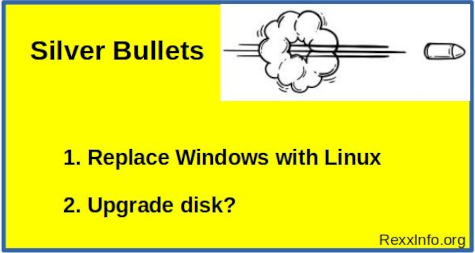
The "big magic" that makes this work is replacing Windows with Linux. Linux runs well on older computers and is highly efficient. It does not enforce planned obsolescence like Windows.
In fact, the reason there are so many good, working computers around to refurbish is because Microsoft artificially kills off hardware by enforcing new hardware demands for new Windows versions.
So whenever Microsoft releases a new Windows, people trash tons of perfectly good computers because they won't run the latest version!
With multicore systems, if the computer has an older technology disk drive, replacing that with a more modern one will work wonders for performance.
My article The Ultimate Guide to Computer Refurbishing tells you everything you need to know refurbish multicore computers, step by step.
My article A Refurbising Experience leads you through how I refurbished a specific computer.
Dual Core Computers
Dual core computers were a transition from the single processor era to our current multicore era.
People have varying opinions on how useful dual core computer systems are. Everyone has their own expectations about what they want to accomplish.
I've found that the technologically adept can use these systems productively. They know how to manage and apply limited computer resources. And, they can handle the less user-friendly interfaces presented by the lightweight Linuxes that run best on these machines. Hobbyists, geeks, and IT pros all qualify.
Naive end users can use these systems productively, too -- but only with key caveats:
- Someone knowledgeable must install and configure the system for them.
- They will require some training or orientation.
- You might have to answer a few questions from them later.
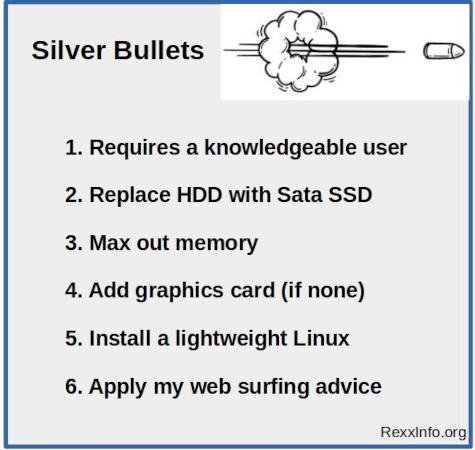
The graphic shows some essential upgrades to dual core systems that greatly increase their utility.
For optimal hardware, replace the old hard disk drive with a Sata connected solid state drive. This dramatically improves performance. These disks cost under $20 USD for the lesser capacities.
Max'ing out memory and graphics power also aids performance.
For software, lightweight Linux distributions for dual core projects I can recommend from personal experience are Puppy Linux and antiX.
If you want to see if a more user-friendly but heavier operating system works for you, try those with lightweight graphical user interfaces (GUIs) like Xfce. From personal experience, two I recommend are Linux Mint/Xfce and MX Linux.
You have to know how to effectively surf the web with a dual core computer. Read my advice on how to web surf with limited resource computers here.
Single Core Computers
Single core computers are over 20 years old as I write this. Can these archaic boxes be of any use?
The answer is Yes.
BUT ... they function adequately only in specific, narrow roles. They don't work as general-purpose home computers because you can't easily surf the web with them. They don't support the modern web's resource requirements.
The internet suggests many potential uses for old Pentiums -- security cam monitors, network-attached storage (NAS) servers, SETI boxes, torrent servers, anonymous Tails servers, private VPNs, Bitcoin miners, programming workstations, thin clients, terminal emulators, routers, file servers, media servers, and more.
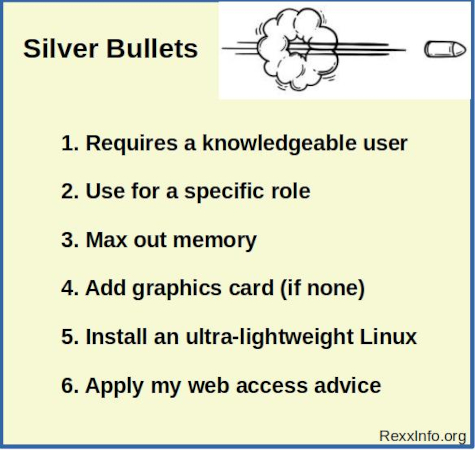
The chart shows a number of improvements you'll want to make to bring any single core computer up to its maximum potential.
The hardware requirements to max out memory and add a graphics card (if absent) are essential.
My article How to Restore Single Core Computers tells you how to refurbish these old machines.
It also shows you how to set up a retro games box that can play thousands of computer games from the DOS era. They're fun for everyone, and nostalgic for those old enough to remember them.
Conclusion
Nearly any multicore computer can be refurbished and put to good use as a good general purpose home computer. You just have to know how to refurbish them, and my articles tell you that.
Dual core computers can possibly fulfill this role as well. But only if used by knowledgeable individuals who understand how to work within their limitations.
Single core systems can be a lot of geeky fun, and educational, too. They can fulfill important roles, but only if their use is carefully matched to specific, narrow functions.
The great news about all of this is, given Microsoft's strategy of planned obsolescence, tons of good working computers hit the recycling centers and the junkyards every day. You can often get this equipment for free, as I detail in my article How to Get a Free Computer.
Click on my articles below for everything you need to know to refurbish an old computer.
Related Articles
Fixing / Refurbishing Computers --
The Ultimate Guide to Computer Refurbishing
How to Refurbish Old Single Core Computers
The Ultimate Guide to Fixing Computer Hardware
PC Evolution -- in Charts
General Interest --
Why You Should Use Generic Computers and FOSS
How to Secure Your Home Wireless Network
How to Get 100% Availability for Your Home Office
Linux --
Linux Performance Tips
How to Upgrade Linux PC Hardware
How to Identify Linux Performance Bottlenecks
Reclaim Big Disk Space by File Conversions
How to Shrink PDF Files
How to Traverse Directories in Scripts
How to Use PUSHD and POPD
Bash to Python Mapping & Comparison
All About Scripting Languages
-----------------------------------
====> Like this free article? Spread the link love to Slashdot, LXer, or your favorite social media. Thank you.